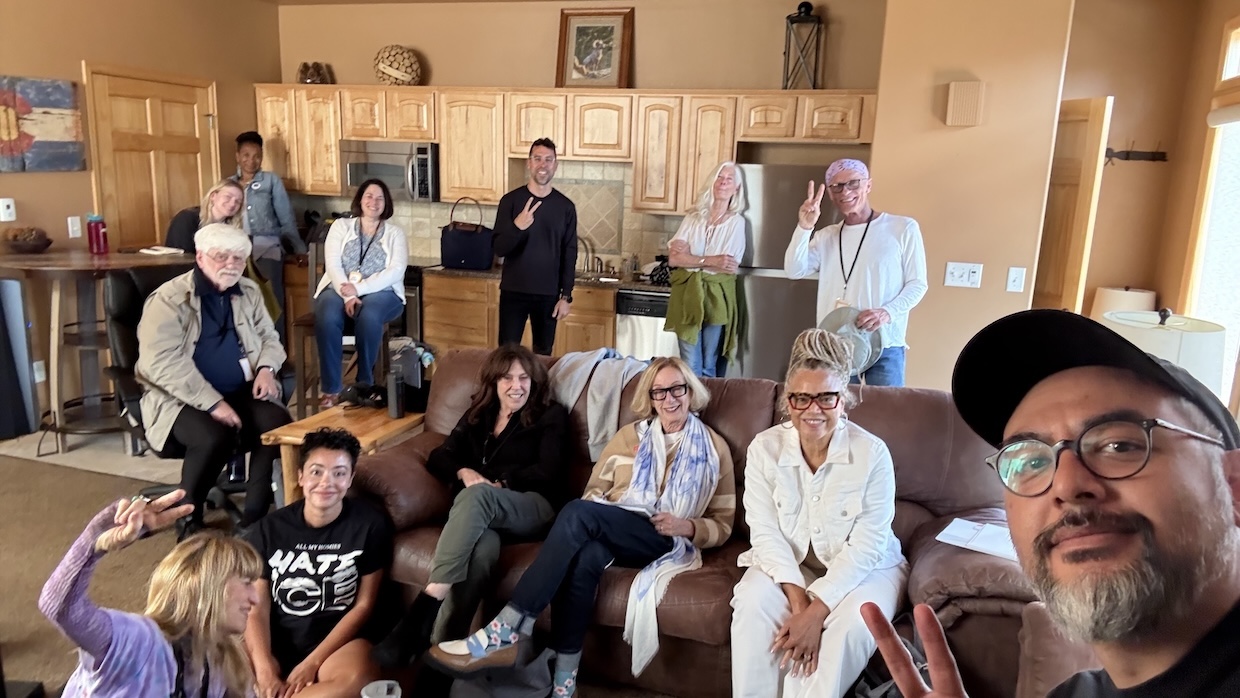 Diffan Sina Norman (right) and advisors on set
Diffan Sina Norman (right) and advisors on set This month Filmmaker is publishing diaries from writers and directors who attended the 2025 Sundance Institute Directors Lab. Today we’re sharing the diary of Diffan Sina Norman, who traveled to the Lab with Sitora. Here’s the description: “A young doctor arrives in a Malay village to establish its first health clinic, jeopardizing the community’s allegiance to a racketeering shaman and his unlikely accomplice: an elusive half-man, half-tiger.” A complete list of Sundance Labs participants can be found here. — Editor
It’s two days after my return from the lab. My memory of the last two weeks are a little hazy and scrunched like an elastic band. I can’t wait to crack open my script, but I start The Godfather at 11 pm and begin writing notes as I’m experiencing it. I can’t seem to get past the first 15 minutes because I’m seeing the film with completely different eyes. This might be the Gyula Gazdag effect (the lab’s artistic director). I’m not sure. Maybe—or, as he puts it, “Why not?”
For me, the lab began with a pre-lap of virtual advisor workshops, assignments and production meetings. The goal heading into the lab was to select two scenes from the latest draft of Sitora and film them on-site. But before we arrived, the ever-generous deputy director of the Sundance Feature Film Program, Ilyse McKimmie, talked us through the opportunities and limitations of exploring scenes at the lab.
I selected two tonally different scenes from my script, vaguely trusting that the lab would be an environment of experimentation and radical failure. Side note: Sitora is a Malay-language daylight horror that unravels in a Malaysian village. How on earth was I supposed to capture that in the middle of Estes Park, Colorado? Easy. I did what Hany Abu-Assad did when he workshopped Paradise Now at the 2003 Directors Lab—I interpreted Sitora as an American adaptation with an all-American cast.
It was a challenge I found intriguing, especially with a diverse cast that included Toan Le, An-Li Bogan, David Zaldívar, Scott Takeda and Jason Potter. Shoutout to our casting directors Eyde Belasco, Kathleen Broyles and Robert Andrus for making it happen. The idea was that we would cast three actors from across the country and two from Colorado. It was an opportunity to see and hear the story with renewed curiosity.
I arrived in Estes Park on Sunday, June 1, and the day started like it had at the Screenwriters Lab, with a circle of advisors, fellows and the Feature Film Program staff. This was the team of dedicated volunteers who would do everything they could to help us realize our two scenes and a mysterious assignment called Osso Buco. From that point on, the days quickly escalated into a series of screeners, acting exercises and directing workshops led by Joan Darling and Gyula Gazdag. These workshops and exercises prepared us with a sense of urgency, adaptability, focus, nourished instincts and openness, all while holding on to our vision.
By day four, we adapted a three-page script entitled Osso Buco in any way we chose, shot for four hours, then edited for another four. The spontaneous nature of the assignment was exhilarating, free of storyboards and open to improvisation. I recall feeling like directing was what I knew best…but with supernatural conviction. Good or bad, the experience inspired collaboration among the crew and it was delightful.
The next day, with the guidance of the production team, we secured one of the available condos to film my first scene—a chill living room that had me wondering: how would my characters adapt from a Malay village setting to a modern holiday cabin in Colorado? That discomfort was something I learned to embrace and explore as the lab went on. It was a feeling that required me to pivot from a fixed idea of my scene and engage with the possibilities that could surface by exploring the material within the given circumstances.
The following day, we rehearsed the scene with our actors under the observation of lab advisors Catherine Hardwicke, Amy Vincent, Nancy Richardson and Kasi Lemmons. Should we move the camera, go wide, stay close or keep it open? More importantly, I learned how to preserve my vision while remaining open to suggestions. To paraphrase an advisor, “Cinema is the art of pivoting.”
Over the next few days, we shot my second scene, supervised by Joi McMillon, Jomo Fray and Jason Reitman. The production revealed some blind spots and new dimensions, and I finished the lab feeling spiritually full and ready to revisit my script with a renewed sense of responsibility and conviction. Almost always, the greatest lessons came at the moments when I overcame the steepest doubt, hesitation and challenges. I truly wish this program upon everyone and feel deeply indebted to its founders. Thank you.
